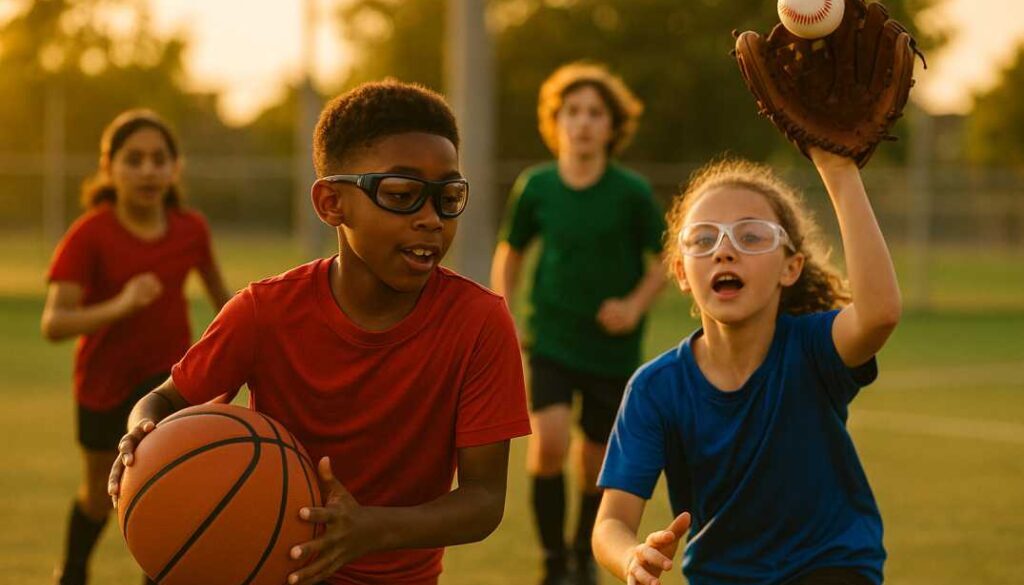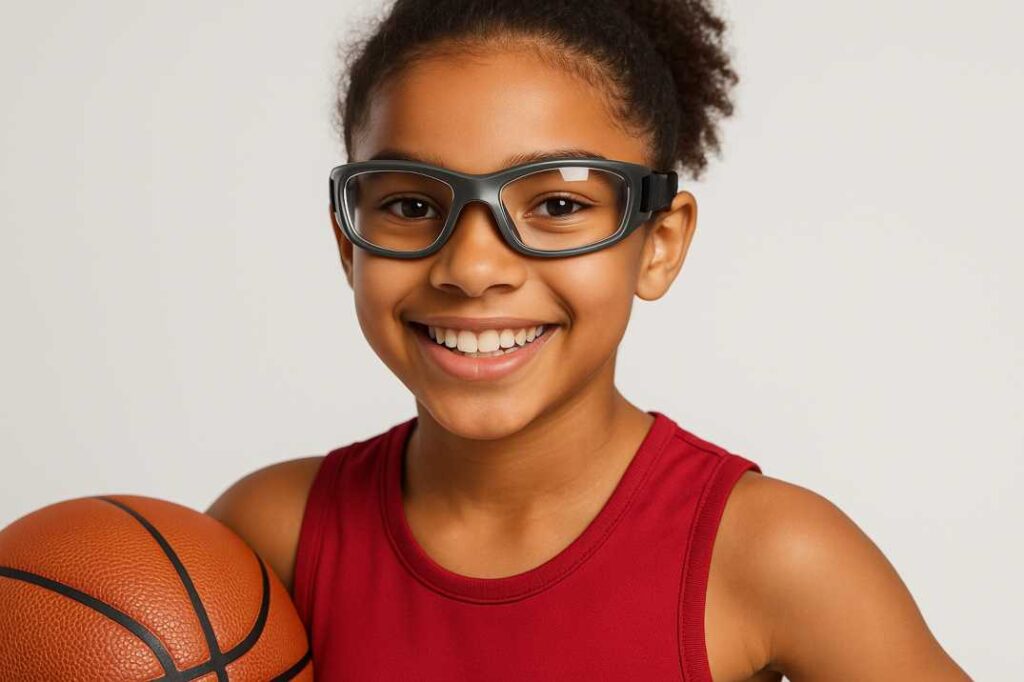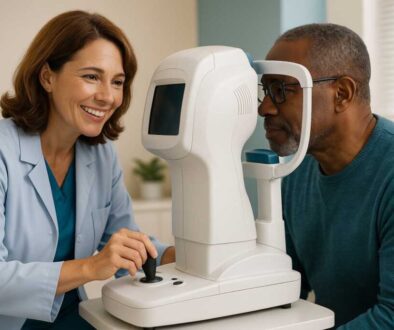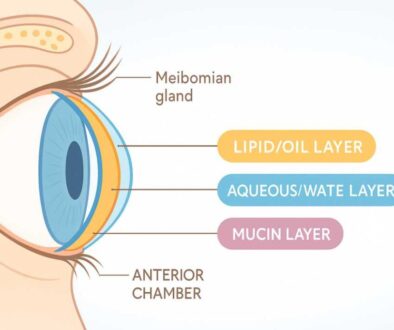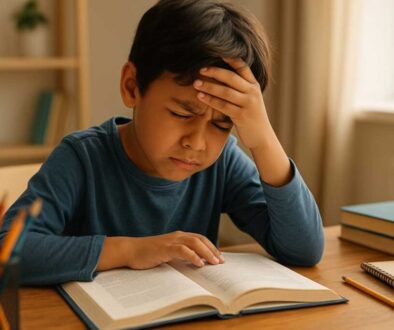Young Athletes: Boost Performance with Sports Vision
Bottom Line Up Front: Sports vision training can improve young athletes’ performance by 20-30% by enhancing visual skills like depth perception, tracking, and reaction time. Meanwhile, proper protective eyewear prevents 90% of sports-related eye injuries. Combining vision training with safety equipment gives young athletes the best chance to excel safely in their chosen sports.
Introduction: Why Vision Is Your Young Athlete’s Most Important Asset
When your child steps onto the field, court, or track, their success depends on split-second decisions. A basketball player tracking a fast break, a baseball player judging a pitch, or a soccer player scanning the field—all these moments rely on one critical factor:
Sports vision. Yet vision in sports goes far beyond simply seeing clearly. It encompasses a complex network of visual skills that can make the difference between good and exceptional athletic performance.
More than 80% of the sensory information athletes use during competition comes from the visual system, making it the dominant sense for athletic success. However, nearly 30,000 sports-related eye injuries are treated in U.S. emergency rooms annually, with 72% occurring in individuals younger than 25 years. Protecting young athletes’ vision has never been more critical.
This comprehensive guide explores both sides of sports vision: enhancing performance through targeted training and protecting your child’s eyes from preventable injury. Whether your young athlete is just starting their sports journey or competing at higher levels, understanding sports vision will help them perform better and play safer.
Understanding Sports Vision: More Than Just 20/20 Eyesight
What Is Sports Vision?
Sports vision is a specialty aimed at improving the performance of the visual system to achieve benefits in practiced sports, as well as in daily life and preventive care. Unlike standard vision testing that measures how clearly you can read letters on a chart, sports vision evaluates and trains the dynamic visual skills athletes need during competition.
Here’s the key difference: having 20/20 vision means your child can see clearly when sitting still, looking at a stationary target. But sports require so much more—tracking moving objects, making quick decisions, coordinating hand-eye movements, and maintaining awareness of teammates and opponents while moving at high speeds.
Essential Visual Skills for Young Athletes
Eye Tracking and Pursuit. Eye tracking is the ability to follow a moving object smoothly and accurately, like a tennis ball or a soccer player in motion. Young athletes must develop this skill to follow fast-moving balls, track teammates, and anticipate plays.
Depth Perception Depth perception helps accurately judge distances, so athletes know how far away a teammate or target is. This visual skill determines whether your child can successfully catch a fly ball, judge when to intercept a pass, or know exactly when to swing the bat.
Peripheral vision allows athletes to monitor the environment outside their central focus, which is especially important in team sports. Basketball players use peripheral vision to spot open teammates while dribbling. Soccer players rely on it to avoid defenders while maintaining control of the ball.
Dynamic Visual Acuity. Dynamic visual acuity is defined as the ability to correctly identify the smallest possible critical detail in a moving visual object at a steady angular velocity. This skill becomes essential in fast-paced sports where balls travel at high speeds, like tennis, baseball, or hockey.
Choice Reaction Time: Choice reaction time measures the time from the arrival of a suddenly presented stimulus until the beginning of the actual action. The athlete with faster visual processing can see the game almost in slow motion, reacting and making decisions in fractions of a second.
Visual-Motor Integration. This skill connects what the eyes see with how the body moves. Strong visual-motor integration allows young athletes to coordinate their movements precisely with visual information—essential for hitting, catching, and shooting skills.
The Science Behind Sports Vision Training
Research-Backed Benefits for Young Athletes
Recent scientific research demonstrates that sports vision skills can be trained and improved, leading to better athletic performance. A systematic review identified 126 articles published between 1997 and 2024 testing sports vision training programs, with most studies reporting improvements in both generic and sports-specific visual abilities.
Study 1: Youth Field Hockey Players Show Measurable Improvements
Research involving male youth field hockey players aged 12-16 years demonstrated that a six-week sports vision training program significantly improved visual performance compared to a control group with no specific sports vision training. The study proved that even relatively short-term interventions can produce meaningful results in young athletes whose visual systems are still developing.
Key Finding: Young athletes’ visual systems are highly trainable, and improvements can happen within weeks rather than years.
Study 2: Enhanced Visual Processing in Youth Athletes
A groundbreaking study combining sports vision training methods with optometric vision therapy in youth athletes resulted in greater efficiency in visual information processing and cognitive resource allocation following 10 weeks of visual training. Researchers used advanced electroencephalographic (brain monitoring) techniques to document these changes objectively, providing concrete evidence of neurological improvement.
Key Finding: Sports vision training doesn’t just help athletes see better—it fundamentally changes how their brains process visual information.
Study 3: Elite Athletes Demonstrate Superior Visual Skills
Comparative research shows that professional and collegiate baseball players demonstrate superior visual acuity, enhanced contrast sensitivity, and improved visual tracking abilities compared to non-athletes. This research confirms that visual skills distinguish top performers from average players, suggesting that developing these skills early could provide long-term competitive advantages.
Key Finding: The visual skills gap between elite and recreational athletes is real, measurable, and can be narrowed through targeted training.
Sports Vision Training: Practical Approaches for Young Athletes
Types of Sports Vision Training
Stroboscopic Training During stroboscopic visual training, individuals practice athletic tasks under intermittent visual conditions with the intention of enhancing subsequent performance under normal visual conditions. Special eyewear creates controlled strobe effects, forcing athletes to use limited visual input more effectively. When they return to normal conditions, their visual processing has improved.
Computer-Based Vision Training Computer-based exercises simulate game situations to enhance reaction speed and decision-making abilities under pressure, allowing athletes to practice responding to visual stimuli quickly and accurately. These programs can be customized for specific sports and skill levels.
Sport-Specific Drills Training that combines oculomotor protocols with sport-specific movements provides the most effective improvements, preparing the visual system for the actual demands of competition. This approach ensures that visual improvements transfer directly to athletic performance.
At-Home Vision Exercises for Young Athletes
While professional sports vision training offers the most comprehensive approach, parents can help young athletes develop better visual skills with these evidence-based exercises:
Pencil Push-Ups for Convergence: A classic convergence exercise where athletes focus on a pencil moving gradually closer to the nose, strengthening the ability to maintain focus on approaching objects—essential for baseball players tracking pitches or goalies following shots. Perform 10 repetitions twice daily.
Near-Far Focus Shifts Rapidly changing focus between close and distant objects improves visual flexibility. Have your athlete practice shifting focus from their finger held at arm’s length to a distant target and back, gradually increasing speed. Start with 20 repetitions and build to 50.
Ball Tracking Drills. Following moving objects enhances peripheral vision and tracking skills. Simple exercises like having your child track a ball being tossed back and forth, or following a pendulum-like motion, can build these abilities. Practice for 5-10 minutes daily.
When to Consider Professional Sports Vision Training
Signs that an athlete may have underdeveloped visual skills include:
- Consistent difficulty catching, hitting, or tracking fast-moving objects
- Frequent complaints of eye strain, headaches, or blurred vision during sports
- Squinting or excessive blinking during play
- Poor depth perception (misjudging distances regularly)
- Difficulty switching focus from near to far objects
- Loss of place when reading or doing homework
If your child consistently struggles with these tasks despite practice, professional evaluation may uncover treatable vision issues that are holding them back.
Vision therapy can be especially effective for kids and young athletes still developing their motor and perceptual skills, supporting long-term athletic and academic success. Early intervention can make a significant difference in both sports performance and classroom learning.
Eye Protection: Safeguarding Your Young Athlete’s Vision
The Scope of the Problem
Eye injuries are a leading cause of blindness in children in the United States, with most occurring during sports participation. Nearly 30,000 sports-related eye injuries are treated in U.S. emergency rooms annually, with 72% occurring in individuals younger than 25 years. However, more than 90% of these injuries can be prevented with appropriate eye and facial protection.
The challenge isn’t just the frequency of injuries—it’s their potential severity. Even a single eye injury can result in permanent vision loss, affecting not only athletic performance but also academic achievement, career opportunities, and overall quality of life.
Common Sports-Related Eye Injuries
Blunt Force Trauma Impacts can lead to bruising or bleeding around the eye, and in severe cases, orbital bone fractures. Basketball, which causes the most sports-related eye injuries in the United States, frequently involves accidental elbows or fingers to the face.
Corneal Abrasions Minor scratches on the cornea often result from contact with fingers, sports gear, or airborne particles like dust. While these injuries usually heal, they’re painful and can temporarily sideline young athletes.
Penetrating Injuries: Objects piercing the eye cause significant damage and increase infection risk. These represent the most serious category of sports eye injuries and can result in permanent vision loss.
UV Radiation Exposure: Athletes in outdoor sports without proper eye protection risk conditions such as photokeratitis or cataracts. Young eyes are particularly vulnerable to UV damage, which accumulates over time.
High-Risk Sports Requiring Eye Protection
The following sports carry the highest risk of eye injury and require appropriate protective eyewear:
Ball and Puck Sports Basketball leads all sports in eye injuries among youth athletes, followed by baseball, softball, racquetball, tennis, soccer, volleyball, hockey, and field hockey.
Combat and Contact Sports Boxing, martial arts, wrestling, and lacrosse involve close contact that significantly increases eye injury risk.
Racquet Sports Tennis, badminton, squash, and racquetball combine high-speed projectiles with confined playing areas.
Other High-Risk Activities: Fencing, paintball, and certain positions in football (despite face masks) require additional eye protection beyond standard equipment.
Understanding Protective Eyewear Standards
Not all protective eyewear provides equal protection. Protective sports eyewear should be designed and manufactured to meet or exceed applicable U.S. ASTM (American Society for Testing and Materials) impact protection standards.
Why Polycarbonate Matters All protective sports eyewear must feature polycarbonate lenses—a type of plastic designed to withstand impact while protecting eyes from ultraviolet rays. Regular eyeglasses have only 4-5% of the impact resistance of polycarbonate lenses of comparable thickness. This material difference can mean the distinction between a minor scare and a serious, potentially life-altering injury.
ASTM F803 Standard. Each sport has a specific ASTM standard based on rigorous impact testing to determine the eyewear’s ability to prevent ocular injury while considering the unique elements of play and equipment associated with that particular sport. When shopping for protective eyewear, always verify ASTM F803 certification specific to your child’s sport—this certification is not optional but essential.
Choosing the Right Protection for Each Sport
Basketball, Soccer, and Volleyball. For these sports, choose protective eye guards with polycarbonate lenses. Wraparound designs provide better protection from peripheral impacts.
Baseball and Softball Use batting helmets with polycarbonate face shields for youth baseball. The face shield should extend far enough to protect both eyes and prevent small balls from entering gaps in the protection.
Hockey players use helmets and face shields approved by the U.S. Amateur Hockey Association when playing hockey. Full cage or shield protection is essential given the high speeds and hard pucks involved.
Swimming and Water Sports Kids need swim safety goggles with polycarbonate lenses when playing sports that happen in water. Prescription swim goggles are available for athletes who need vision correction.
Outdoor Sports: For baseball, softball, cycling, and golf, sports sunglasses should provide 100% UVA-UVB protection. Polarized lenses can reduce glare and improve visibility.
Fitting Protective Eyewear Properly
Proper fit is critical for both protection and comfort. Check the fit of your child’s sports eyewear at the start of every season—if the glasses or goggles are too large or too small, the protection they provide will be compromised, significantly increasing the risk of eye injury.
Essential Fit Requirements:
- The eyewear stays securely in place during vigorous movement
- No gaps exist that could allow objects to reach the eyes
- Your child can see clearly in all directions without obstruction
- Comfort level encourages consistent use rather than removal during play
Eyewear should remain stable when you move your head from front to back and side to side. Frame straps should be adjusted to ensure they’re neither too tight (causing discomfort) nor too loose (allowing movement). Never compromise on fit—poorly fitted protection offers a false sense of security.
Addressing Common Concerns About Protective Eyewear
“It Will Hurt My Child’s Performance.” Studies show that protective eyewear does not hinder sight and can actually aid performance because players do not worry about sustaining an eye injury and can instead devote their full attention and effort to their performance. Confidence matters in sports, and knowing their eyes are protected allows young athletes to play more aggressively and confidently.
“My Child Already Wears Glasses” Regular eyeglasses, sunglasses, and contacts don’t protect kids from eye injuries—but most protective eyewear can be made to match kids’ glasses or contact prescriptions. Many families find that prescription protective eyewear actually works better for sports than regular glasses.
“It Looks Uncool.” Today’s sports eyewear has evolved dramatically. Modern designs look stylish and professional, with many professional athletes wearing protective eyewear. When the whole team wears appropriate protection, it becomes normalized rather than stigmatized.
Sports-Specific Vision Considerations
Baseball and Softball: Vision Skills That Win Games
Baseball and softball demand exceptional visual skills. Players must track a small, fast-moving ball against varying backgrounds, judge its trajectory, and make split-second decisions about whether to swing or where to throw.
Critical Visual Skills:
- Dynamic visual acuity for tracking pitched balls
- Depth perception for judging fly balls
- Hand-eye coordination for hitting
- Peripheral vision for base running and defensive positioning
Protection Needs: Face guards on batting helmets, protective sunglasses for outfielders, and polycarbonate eyewear for all positions.
Basketball: 360-Degree Visual Awareness
Basketball requires constant visual awareness of teammates, opponents, and the ball—all while moving at high speed. Basketball is associated with the most eye injuries among young players, primarily from accidental contact.
Critical Visual Skills:
- Peripheral vision for court awareness
- Depth perception for shooting and passing
- Eye tracking for following the ball
- Quick visual decision-making
Protection Needs: Protective goggles with wraparound design and secure straps are essential, especially for younger players.
Soccer: Tracking in Chaos
Soccer players must track the ball, teammates, and opponents across a large field while running. They need excellent peripheral vision and the ability to quickly shift focus between near and far objects.
Critical Visual Skills:
- Peripheral vision for field awareness
- Depth perception for heading balls
- Dynamic visual acuity while running
- Visual anticipation of plays
Protection Needs: Sports goggles protect against accidental kicks, elbows, and collisions. Sunglasses with UV protection for outdoor play.
Tennis and Racquet Sports: Precision Tracking
Racquet sports involve tracking a fast, small object against various backgrounds while coordinating complex movements. The ball can travel over 100 mph in advanced play.
Critical Visual Skills:
- Dynamic visual acuity
- Hand-eye coordination
- Depth perception
- Contrast sensitivity
Protection Needs: Polycarbonate protective eyewear rated for racquet sports, sunglasses for outdoor tennis.
Creating a Comprehensive Sports Vision Program for Your Young Athlete
Step 1: Baseline Vision Assessment
Before starting any sports season, ensure your child receives a comprehensive eye examination. Good vision is essential for good performance, so make sure to have an annual eye exam to ensure that prescriptions are up-to-date. A sports-focused examination should evaluate:
- Standard visual acuity (distance and near)
- Depth perception
- Peripheral vision
- Eye tracking ability
- Hand-eye coordination
- Focusing flexibility
Step 2: Address Vision Problems Early
When one of these skills is underdeveloped or impaired, an athlete may miss opportunities, react more slowly, or struggle to perform consistently. Don’t assume that struggles on the field are due to a lack of athletic ability—they may stem from treatable vision problems.
Common correctable issues include:
- Myopia (nearsightedness)
- Hyperopia (farsightedness)
- Astigmatism
- Convergence insufficiency
- Tracking difficulties
Step 3: Implement Sports Vision Training
Sports vision enhancement hones an athlete’s ability to process visual information rapidly, enabling young athletes to make faster, smarter decisions on the court or field. Work with your eye care professional to develop an appropriate training program based on your child’s age, sport, and current skill level.
Step 4: Ensure Proper Protection
Make protective eyewear non-negotiable equipment, just like shin guards or helmets. Protective eyewear should be comfortable, secure, and appropriate for the athlete’s age and size. Replace damaged or outgrown equipment promptly.
Step 5: Monitor and Adjust
As your young athlete develops, their visual needs may change. Schedule regular check-ups, especially if you notice:
- Declining performance
- Complaints of eye strain or headaches
- Squinting or rubbing eyes during play
- Difficulty judging distances
- Avoiding certain plays or positions
The Role of Parents and Coaches in Sports Vision
Supporting Your Young Athlete
Communication Is Key. Talk to your child about any vision-related challenges they experience. Young athletes may not recognize that their visual struggles aren’t normal, assuming everyone sees the way they do.
Make Protection Normal: Make protective eyewear part of the standard equipment from the get-go. When protection is treated as essential rather than optional, children are more likely to wear it consistently.
Look for Warning Signs. Signs that an athlete may have underdeveloped visual skills include difficulty catching, hitting, or tracking fast-moving objects. Watch for patterns in mistakes or consistent struggles with specific skills.
Coach Considerations
Coaches play a vital role in emphasizing both vision training and protection. Consider incorporating simple vision drills into warm-up routines and making protective eyewear a team requirement for high-risk sports.
Concussion and Vision: An Important Connection
Eye injuries in sports can result from UV exposure in outdoor sports, but consequences can also include significant vision loss, sometimes permanently, affecting an athlete’s ability to perform daily activities. Additionally, concussions can severely impact vision.
Sports-related concussions can cause:
- Blurred or double vision
- Sensitivity to light
- Difficulty focusing
- Problems with eye tracking
- Reduced peripheral vision
If your young athlete suffers a head injury, ensure they receive a comprehensive evaluation that includes vision testing. Vision problems following a concussion require specialized treatment and should never be ignored.
Looking Ahead: The Future of Sports Vision
Sports vision continues to evolve with technological advancement. By 2025, sports vision training will have evolved dramatically, with virtual reality platforms and eye-tracking tools now customizing programs for every age group. These innovations make training more accessible, engaging, and effective for young athletes across all skill levels.
Emerging Technologies:
- Virtual Reality Training: Allows athletes to practice visual skills in simulated game situations, providing repetitions that would be impossible or impractical in real settings
- Eye-Tracking Technology: Provides objective measurements of visual performance, allowing for precise monitoring of improvement over time
- AI-Powered Assessment: Machine learning algorithms can identify subtle visual deficits and create personalized training protocols
- Wearable Technology: Smart glasses and sensors track visual performance metrics during actual competition
These technological advances complement—but don’t replace—the fundamentals of good vision care, protective equipment, and professional guidance from qualified eye care specialists.
Scientific References and Resources
This article is supported by peer-reviewed research and authoritative sources. Below are three key resources cited throughout:
1. Training Vision in Athletes to Improve Sports Performance: A Systematic Review
Source: Taylor & Francis Online – Psychology of Sport and Exercise
Published: December 2024
Link: https://www.tandfonline.com/doi/full/10.1080/1750984X.2024.2437385
This comprehensive systematic review analyzed 126 articles published between 1997 and 2024 on sports vision training programs. The research demonstrates that sports vision training regimens involving drills aimed at improving visual sensitivity, depth perception, tracking, reaction time, and hand-eye coordination lead to measurable improvements in athletic performance. This study provides the foundational evidence that specific aspects of visual function can be enhanced through training, supporting the effectiveness of sports vision programs for young athletes.
2. Role of Sport Vision in Performance: Systematic Review
Source: Journal of Functional Morphology and Kinesiology (PMC)
Published: May 2024
Link: https://pmc.ncbi.nlm.nih.gov/articles/PMC11204951/
This systematic review from 1950 to 2023 examined how sport vision training improves athletic performance across different sports and age groups. The research confirms that good visual processing and high reaction speed distinguish excellent performance, and these capabilities can be improved with sport vision training in any athlete, regardless of level. The study emphasizes that athletes with better visual reaction speed can see the game almost “in slow motion,” allowing them to react and make decisions in fractions of seconds ahead of competitors.
3. Sports Eye Safety Resources
Source: American Academy of Ophthalmology
Updated: March 2024
Link: https://www.aao.org/eye-health/tips-prevention/injuries-sports
The American Academy of Ophthalmology provides authoritative guidance on preventing sports-related eye injuries. Their research shows nearly 30,000 sports-related eye injuries are treated in U.S. emergency rooms annually, with 90% of serious eye injuries preventable through appropriate protective eyewear. This resource offers evidence-based recommendations for protective equipment standards (ASTM F803) and sport-specific safety guidelines that parents and coaches can implement immediately.
Additional Authoritative Resources:
- National Eye Institute: Sports and Eye Safety Guidelines –
https://www.nei.nih.gov/learn-about-eye-health/healthy-vision/sports-and-eye-safety-tips-parents-and-teachers - International Sports Vision Association: Protective Eyewear Standards – https://www.sportsvision.pro/athletes/protectpreventplay/about-protective-eyewear/
- American Academy of Pediatrics: Policy Statement on Protective Eyewear for Young Athletes
Conclusion: Investing in Your Young Athlete’s Visual Future
Sports vision encompasses both performance enhancement and injury prevention. By addressing both aspects, you give your young athlete the best possible foundation for success and safety.
Key Takeaways:
- Vision provides more than 80% of the sensory information athletes use, making it the most important sense in sports.
- Sports vision skills can be trained and improved, with measurable benefits appearing within weeks.
- Ninety percent of sports-related eye injuries are preventable with proper protective eyewear.
- Vision problems that affect athletic performance often impact academic success as well.
- Early intervention and consistent protection create long-term benefits
Remember: Whether your child dreams of professional athletics or simply enjoys recreational sports, optimizing their vision enhances their experience, builds confidence, and protects their lifelong eye health. The investment you make in their sports vision today pays dividends far beyond the playing field.
Ready to take action? Schedule a comprehensive sports vision assessment with a qualified eye care professional who understands the unique visual demands of athletics. Your young athlete’s vision is too important to leave to chance—protect it, train it, and watch them excel.
About West Broward Eyecare Associates
At West Broward Eyecare Associates in Tamarac, Florida, we understand the critical role vision plays in your young athlete’s success and safety. Our comprehensive sports vision programs combine cutting-edge assessment technology with proven training protocols, while our extensive selection of protective eyewear ensures your child has the right protection for their sport.
From your child’s first eye exam to specialized sports vision training, we’re here to protect and enhance the gift of sight for every stage of life. As your neighbors and your vision guardians, we combine cutting-edge eye care technology with the personal attention your family deserves.
Schedule Your Young Athlete’s Sports Vision Assessment Today
Contact West Broward Eyecare Associates to learn how we can help your child see better, play better, and stay safer on the field. Visit our Tamarac office or call to book your comprehensive sports vision evaluation.
West Broward Eyecare Associates | Tamarac, Florida
Medical Disclaimer: This article is for informational purposes only and does not constitute medical advice. Always consult with a qualified eye care professional for diagnosis and treatment recommendations specific to your child’s needs. Individual results from sports vision training may vary.
FAQs
-
Sports vision training teaches visual skills like tracking, focus, and reaction time to help young athletes perform better in sports, both safely and competitively.

